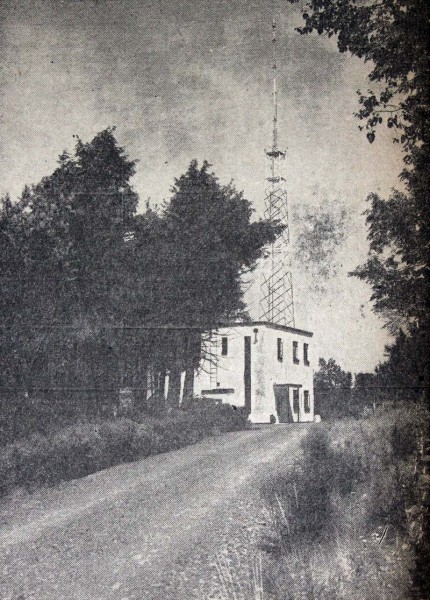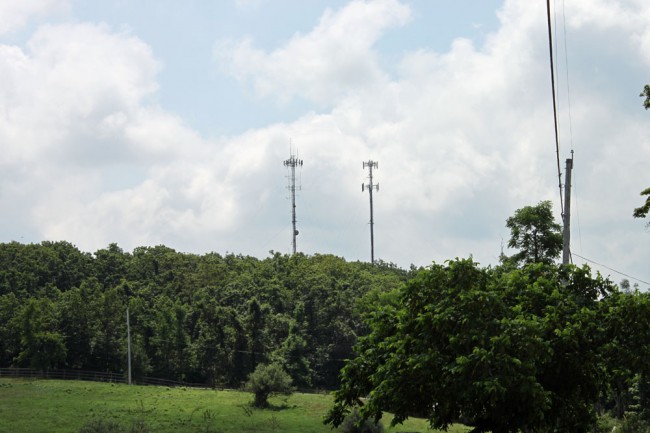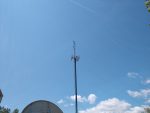On June 19th, WKZE received a notice of violation from the FCC’s New York Field office. The crux of the issue seems to be interference being generated on 784.8 MHz (WKZE 8th harmonic) to a new Verizon Wireless installation located nearby:
47 C.F.R. §73.317(a): “FM broadcast stations employing transmitters authorized after January 1, 1960, must maintain the bandwidth occupied by their emissions in accordance with the specification detailed below. FM broadcast stations employing transmitters installed or type accepted before January 1, 1960, must achieve the highest degree of compliance with these specifications practicable with their existing equipment. In either case, should harmful interference to other authorized stations occur, the licensee shall correct the problem promptly or cease operation.” The eighth harmonic of Station WKZE-FM (784.8 MHz) was causing interference to the Verizon Wireless transmitter located approximately 500 feet away.
First off, we note that the WKZE transmitter is not allegedly causing interference to a Verizon Wireless transmitter, but rather to a Verizon Wireless receiver. That may be splitting hairs, however, since the FCC is quoting a technical rules violation, they can at least get the technical language right.
A brief examination of the rest of FCC part 73.317 is in order to find the specification cited in section (a). Section (d) states:
(d) Any emission appearing on a frequency removed from the carrier by more than 600 kHz must be attenuated at least 43 + 10 Log10 (Power, in watts) dB below the level of the unmodulated carrier, or 80 dB, whichever is the lesser attenuation.
Since 784.8 MHz – 98.1 MHz is greater than 600 KHz, this is the section that applies to the WKZE situation. Thus, the interfering signal must be greater than -80 dBc to trigger the Notice Of Violation (NOV) from the FCC. The station ERP is 1,800 watts or +62 dBm. Measurements were made with an Agilent N992A spectrum analyzer using an LPA-1000 log periodic antenna. At a 12-foot distance away from the WKZE transmitter cabinet, the signal on 784.8 MHz was found to be -94 dBc or 0.000063 watts. At the base of the Verizon Wireless tower, the measurement was -124 dBc, or 0.000000025 watt, which is barely perceptible above the -130 dBm noise floor. There does not appear to be any violation of 47 CFR 73.317. Rather, the issue seems to be Verizon Wireless’s deployment of the 700 MHz LTE band and the use of high-gain antennas coupled with high-gain preamplifiers on frequencies that are harmonically related to broadcast stations nearby. In this particular installation, the antenna has 16 dB of gain, minus a 4.5 dB of transmission line loss into a 21 dB preamplifier before the receiver. At the output of the Verizon preamplifier, the signal on 784.8 MHz was measured at -89 dBc, which is still in compliance.
By these measurements, clearly, WKZE is not in violation of any FCC regulation. It makes one wonder, does the FCC understand its own rules? Or, is this a matter of favoritism towards a huge corporation over a small independent radio broadcaster? Is it a matter of “broadband at the expense of all others?” There are several of these broadcast to 700 MHZ LTE interference cases pending throughout the country. This could set a dangerous precedent for broadcasters and other RF spectrum users as wireless giants like Verizon throw their weight around and eye even more spectrum to press into broadband service.
Commlaw blog has a good post on this subject: Harmonic Convergence?
Update: The response from the WKZE attorney can be found here, including the above-mentioned actual measurements.






Never had the pleasure of a visit but wasn’t there a time the FCC would investigate the problem before writing the notice? Sounds like they never even been to the site.
Kinda like the cop giving you the speeding ticket before you even left the driveway.
You’d also think that the actual emission level would have been mentioned in the NOV. When an AM station is found to be transmitting with more than licensed power, some numeric data (physical measurement or meter readings) is always provided. Unfortunately the station will now have to waste a lot of money proving their cleanliness while the cellphone lawyers get richer.
Barry Mishkind has several editorials about this exact issue.
I have been burned by a version of this, back in analog TV days when a ch. 13 TV station put in a new, solid-state transmitter and the trustee of a 220 MHz ham repeater a couple of miles away complained. His noise floor was up! …Didn’t help that he was running a couple of preamps cascaded on the input to repeater.
The transmitter exceeded FCC spec for out-of-channel noise by a good margin — if you looked with a good spec. an., though, you could see about a 10 dB “platform” above the noise floor, the exact width and shape of the 10%-of-center-freq bandpass filter in the exciter, the only RF filter element in the transmitter other than the (high-level) aural/visual diplexer.
Pointing out that the transmitter more than met the FCC limit was of no avail; the *real* standard, we were told by the feds, lay elsewhere in the regs: we were required to “not interfere with other services.”
Long story short, replacing the ch. 13 filters with ch. 12 filters (still some 20 MHz wide) pulled the upper edge of the “noise platform” out of the ham and 2-way bands, at the cost of more tweaking to get differential phase & gain and ICPM back to pretty levels.
But it was quite a shock to learn that a brand-new, way cleaner than required transmitter was still not good enough, despite complying with what we knew to be the letter of the law.
I’m hoping the 700 MHz mess won’t be quite that painful, but it may be, and those outfits have deeper pockets and more influence than a ham radio club. 🙁
I see that WKZE replied to the NOV, including their own measurements and a little bit of bragging (never hurts), turning the issue squarely over to the FCC & Verizon side to prove things. Bravo. Read the full response on Barry’s site.
The FCC is always there to serve it’s constituents, the telecom cartels. The cartels would REALLY be happy if these annoying 20th century users of radio spectrum, such as terrestrial broadcasting, land mobile radio, ham radio, etc would just magically leave so they can continue their goal to make every living thing a paying subscriber to their one-sided contracts of adhesion for their “value added” services.
I mean, who NEEDS radio, TV, two way radio, GPS, or anything else when “there’s an app for that”? Right?
And this is what happens when the spectrum is sold to the highest bidder, the new “owner” expects results, has lots of money and lawyers and doesn’t give a fuck about what the rules say.
Everything is for sale.
Forget those damned apps,…I’ll take traditional radio,TV,two way radio,and GPS over those damned apps. I have a bunch of apps on my smart phone that I don’t even use,…I’ll be damned if I add any more! In the case of this article,…why would WKZE be served a violation notice if the measurements were in spec?
why would WKZE be served a violation notice if the measurements were in spec?
Which is the curious part
This is going in my notes file. I love the way the lawyer rebutted that. *That* is how to handle a complaint or coordination issue when you’re in specifications.
I am curious about the outcome of the other violations noted (footnote 14)in the Attorney’s letter.
About 30 years ago, I had the opportunity to investigate a LMR UHF community repeater in Iowa that my employer, Motorola, had installed on a tall broadcast tower. Apparently, for some reason, the frequency had recently been changed, and as a result, the users who had claimed 100 mile mobile coverage (flat lands), now got less than 10 miles. I checked the effective sensitivity and found the noise floor was severely elevated. A broadcaster on the tower was emitting a fifth harmonic including 5X modulation bandwidth, that pretty much wiped a portion of the UHF LMR band. The fix, ultimately was to change the frequency back to near where it was originally.
This was last year now; did we ever hear about the outcome, Paul?
(Someone mentioned the story in a FB broadcasters group today…)
No news yet, it sometimes takes the commission a long to to respond to things like this, it may be more than a year or two until finally answer.